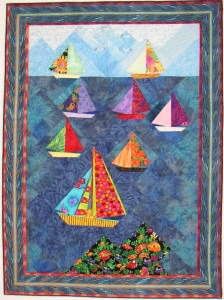Ruth, one of my students in the class at Eddie’s Quilting Bee, had some questions about Foundation Paper Piecing for me. She said that she has seen designs that she liked in store and magazines, but was intimidated because she didn’t know what this particular quilting method entailed.
So her questions were:
“Is there a difference in the two methods?”, “How easy is the process?”, and “Could I show this in my lecture that evening?”
I responded with some details on the history of these topics and what they mean. I also told her about how I created my method to be very simple and to guarantee placement of fabric without any waste. (My method solves the two main reasons people do not like foundation paper piecing.) I demonstrated it at my lecture that evening just for her. After more and more requests for this lesson I decided to put “Foundation Paper Piecing” high on the priority list for our video series. Now I am excited to announce that it is here!
As for the history of Foundation Paper Piecing, there seems to be several opinions as to what the terms mean. Here is my perspective based on my experience:
 When I first learned quilting in the 1980’s, I was taught everything by hand: making templates, cutting with scissors, hand piecing, and hand quilting. The rotary cutter had not made the scene yet. At that time, anyone who mentioned paper piecing always meant English paper piecing. This technique uses a template that does not have a seam allowance; the fabric is folded around the template and basted to the paper. The edges are then aligned and the pieces are whip-stitched together. Many 60-degree designs like grandmother’s flower garden and tumbling blocks are often pieced using this method. In fact, there are companies that sell pre-cut papers specifically for this. When I hear paper piecing, that is what I think of first.
When I first learned quilting in the 1980’s, I was taught everything by hand: making templates, cutting with scissors, hand piecing, and hand quilting. The rotary cutter had not made the scene yet. At that time, anyone who mentioned paper piecing always meant English paper piecing. This technique uses a template that does not have a seam allowance; the fabric is folded around the template and basted to the paper. The edges are then aligned and the pieces are whip-stitched together. Many 60-degree designs like grandmother’s flower garden and tumbling blocks are often pieced using this method. In fact, there are companies that sell pre-cut papers specifically for this. When I hear paper piecing, that is what I think of first.
Then there is the tradition of foundation piecing as used for log cabin blocks or Victorian crazy quilts. This style uses pieces of fabric sewn to a foundation to create the design. Traditionally scrap fabric including sugar or muslin flour sacks is used for this. The foundations did not have any pattern printed on them. Rather, the design was added with precise seams or randomly; depending on the expected design.
Then the method of having the design printed on the foundation and sewing on the line was developed. As foundation piecing grew in popularity, some designers started calling it paper piecing because the foundation was paper. There are many different methods that have developed over the years. A great resource is “The Experts’ Guide to Foundation Piecing” by Jane Hall, published by C&T Publishing, 2006.
I prefer to call the technique either “foundation piecing” or “foundation paper piecing” because the method is a type of foundation piecing. By calling it “foundation paper piecing”, it distinguishes it from English paper piecing.
I am excited to share this method via video because I have working with it for almost 10 years, published it twice in magazines, and shared the basic concept in Jane’s book.
Foundation paper piecing is easy and everyone can do this! Now that I’ve developed this method, there have been very few instances where I have had to rip: When I sew the wrong fabric in a particular section, when I sew right side to wrong side (instead of right side to right side – must be time to take a break :), or when the fabric slips because I did not bother to pin it in place. (This is one place where I do recommend pinning). To me this is exciting because we know before we sew that it is going to fit!
Please let me know if you have any questions and as always… Enjoy your quilting!
Marci


Leave a Reply
You must be logged in to post a comment.